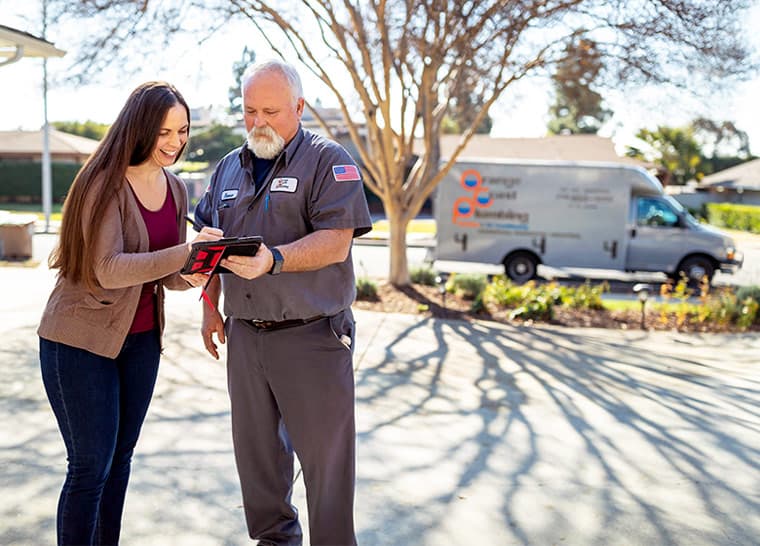Halfway through your shower, the water runs cold.
Since you’re all soaped up, you have two options.
- You can shiver through the rest of your cold water shower (good for activating brown fat cells).
- You can dry off as is, with soap and all.
Wim Hof, “The Iceman,” would promote option #1.
A plumber might tell you there’s yet another option: a water heater service call or upgrade.
There may be several reasons for your hot water shortage. Here are a few of them.
1. Too Much Simultaneous Hot Water Use
A large washing machine on a hot water cycle and two running showers could quickly max out your water heater.
By law, all California homes should have low-flow showerheads and faucets. But if you have old fixtures or live in a state with no water restrictions, water may pour out of the showerhead at up to 5.5 gallons per minute. Even a space-age tankless heater would struggle to keep pace.
In 2023, California law requires that bathroom faucets use no more than 1.2 gallons per minute (GPM). Residential showerheads have an upper limit of 1.8 GPM.
Simply by upgrading the water fixtures in your home and running your washer at night, you may solve your hot water shortage.
2. A Too-Small Water Heater Tank
Your hot water demands should be at most 75% of your heater tank’s capacity.
So if you have a 50-gallon tank, your hot water budget is 37.5 gallons.
Hot water consumption adds up fast in a busy home. A top-loading machine washer on hot wash can drain 25 gallons. Older showerheads and faucets do a poor job of restricting hot water flow.
If you’re exceeding your water heater’s capacity, you may need a new water heater with a bigger tank or a tankless water heater that delivers hot water on demand.
On a related note, you should set your water heater to 120 degrees F or lower. This does a couple of things.
- It ensures you’re not overworking your water heater.
- It protects your family and pets against scalding, a problem with the default water heater setting of 140 degrees F.
3. Mineral Build-up in Your Water Heater, Reducing Efficiency
Sediment build-up is especially common in older water heaters.
Calcium and iron can accumulate on heating elements, leading to energy loss, water contamination, and eventual rusting of tank walls.
Flush your heater every two years and watch for rusty pipes or fittings throughout your home’s water system. If you see rust or sediment in hot water, it’s time to call a plumber for a water heater tune-up.
4. Faulty Water Heater Components
Several water heater components need regular inspections and maintenance for efficient and safe operation.
- The thermostat regulates the temperature of the hot water in the tank, allowing it to reach temperatures up to 140 degrees F.
- The heating elements warm the water.
- The pressure valve is an emergency shut-off switch in case of excessive pressure buildup.
- The anode rod protects the tank from corrosion by attracting minerals and other deposits.
Check the thermostat periodically to ensure a 120 degrees F or lower setting.
A professional should do other inspections unless you’re the rare DIYer who knows how to work on a water heater without blowing up your home.
5. A Faulty Thermocouple in an Older Gas Water Heater
The thermocouple keeps your gas heater’s pilot light on and working correctly.
If your thermocouple is on the fritz, it won’t detect when the pilot light has gone out. Cold water will be the least of your concerns when gas leaks into your home or garage.
Call for service immediately if a gas water heater is acting up.
Conclusion
Cold showers are great for brown fat activation and controlling inflammation.
They’re not so great for comfort (unless you’re Wim Hof) or keeping the peace in the family.
Standard water heaters last an average of 7-10 years. Their performance often declines as they reach the 10-year mark.
A plumber can give you the lay of the land, report on the condition of your hot water system, replace your water heater if need be, and repair anything that needs fixing — including leaky hot water pipes.
Don’t shiver in silence. Call us for service. You’ll be glad you did.


